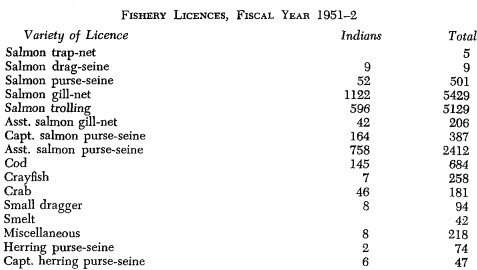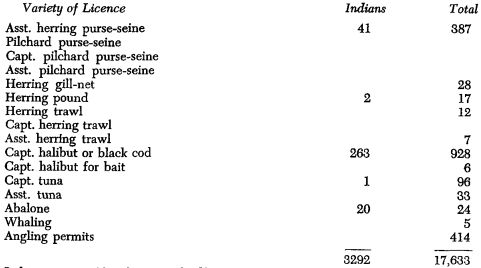No CrossRef data available.
Article contents
Native Indians and the Fishing Industry of British Columbia*
Published online by Cambridge University Press: 07 November 2014
Extract
Contemporary industry and society have brought major changes to the economic and social life of the Indians of British Columbia. Most tribal cultures were built upon a simple small-scale base. The tribal band was typically small and closely knit with personal relationships; the individual's status and role were clearly defined, and his activities regulated by tradition. Hunting, fishing, and gathering supplied a livelihood. Equipment and techniques were generally simple and static. Most of the output was for the local community's own use: only a small fraction was bartered for the products of other groups.
The new economic system and the way of life associated with it is almost the direct antithesis of the tribal system outlined above. Today the Indian is involved in a large-scale and increasingly complex system of production and distribution, characterized by dynamic, rapidly changing techniques, a steadily increasing use of automatic power-driven machinery, and a growing production for national or international markets rather than for local use. As worker or producer he has, with few exceptions, lost his direct ownership of, or control over, his means of production. Relationships, defined increasingly by the market rather than by custom, have become more impersonal.
Comparatively few Indians have managed to derive full advantage from the new way of life. Tribal cultures have been disorganized or destroyed, and with them has gone the whole structure of role and status that made life meaningful for individuals. Indians have faced formidable difficulties in acquiring the economic incentives of the white man's culture, and the equipment and techniques with which to meet them. The result has been, in all too many cases, deterioration of morale, apathy, and economic dependency. Indians have become a marginal labour group in many areas: living on reservations, depending upon the government for a large part of their subsistence, and employed only casually in unskilled or menial jobs of a type that other workers avoid.
- Type
- Research Article
- Information
- Canadian Journal of Economics and Political Science/Revue canadienne de economiques et science politique , Volume 19 , Issue 1 , February 1953 , pp. 20 - 34
- Copyright
- Copyright © Canadian Political Science Association 1953
Footnotes
Some of the ideas expressed in this article are necessarily repetitious of those to be found in the two articles by Stuart Jamieson and Percy Gladstone, “Unionism in the Fishing Industry of British Columbia,” Canadian Journal of Economics and Political Science, Feb., 1950, 1–11; May, 1950, 146–71.
Grateful acknowlegement is made of a grant from the Canadian Social Science Research Council facilitating this study.
References
1 Estimate of the Native Brotherhood of British Columbia.
2 A. H. Ainsworth, “Conservation in the British Columbia Salmon Industry,” unpublished B.A. thesis, April, 1946, University of British Columbia, p. 18.
3 Report of Fisheries Commission for British Columbia, 12 31, 1918, 12.Google Scholar
4 Report of Fisheries Commission for British Columbia, 12 31, 1920, 13.Google Scholar
5 See also Jamieson and Gladstone, “Unionism in the Fishing Industry of British Columbia,” 5–6.
6 The statistics on licences issued were furnished by the Federal Department of Fisheries, 1110 West Georgia Street, Vancouver, B.C. The number of licences issued is no indication of the ratio of fish caught. It would be interesting to find out what proportion of the total catch of fish was caught by Indian fishermen but at the present time investigation of this question is not possible.


Indian permits (for domestic food) 1848
7 Only the captain of the boat and not the fishermen require a licence.
8 Indians participated in all disputes listed and described in Gladstone and Jamisson, “Unionism in the Fishing Industry of British Columbia,” 146–71. The present article is confined to reports of actual participation of Indians in the strikes.
9 Vancouver Daily Province, 07 16, 1900, 3.Google Scholar
10 See fuller list of disputes in Jamieson and Gladstone, “Unionism in the Fishing Industry of British Columbia,” 148–52.
11 Vancouver Daily Province, 07 14, 1893, 4.Google Scholar This and subsequent quotations are given not so much for their factual accuracy as for the indication they give of the attitudes and expressions of the parties involved in the disputes.
12 Vancouver Daily Province, 07 15, 1893, 2.Google Scholar
13 Vancouver Daily World, 07 24, 1893, 2.Google Scholar
14 Ibid.
15 From the diary of R. Cunningham, pioneer cannery operator of Port Essington, B.C., which was the centre of early Skeena River fishing.
16 Vancouver Daily Province, 07 24, 1900, 1.Google Scholar
17 Vancouver Daily Province, 05 31, 1901, 9.Google Scholar
18 Vancouver Daily Province, 07 22, 1901, 1.Google Scholar
19 Vancouver Daily Province, 07 20, 1901, 1.Google Scholar
20 Report (Ottawa, 1902), 390.Google Scholar
21 Vancouver Doily Province, 07 22, 1901, 1.Google Scholar
22 Vancouver Daily Province, 07 13, 1904, 1.Google Scholar
23 Vancouver World, 07 19, 1907, 73.Google Scholar
24 Vancouver Daily Province, 07 27, 1907, 7.Google Scholar
25 Ibid.
26 Young, C. H. and Reid, H. R. Y., The Japanese Canadians (Toronto, 1938), 43.Google Scholar
27 Vancouver Daily Province, 07 15, 1922, 7.Google Scholar
28 Concerning the pioneering phase of this development there is some dispute. Another version is that the Finns of Sointula accidentally discovered the possibility of gill-netting in the Straits.
29 Indian Agency, Alert Bay, B.C.




